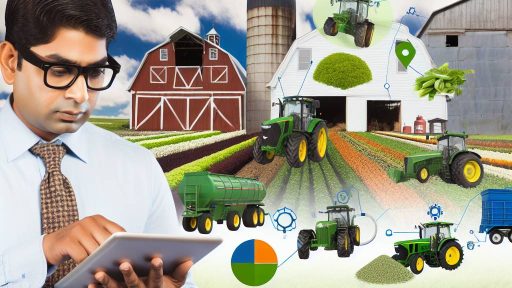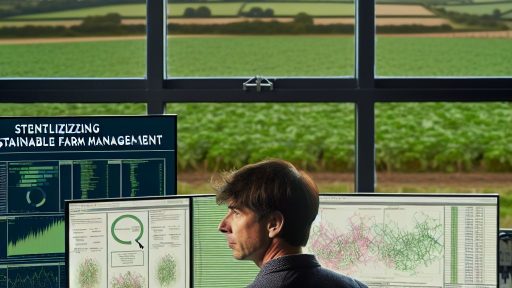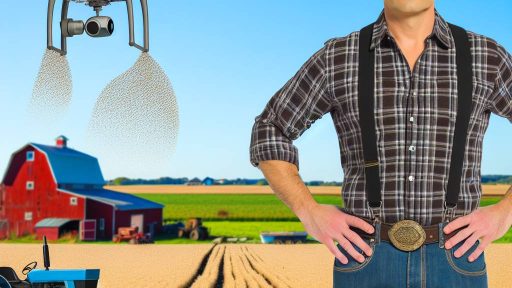Introduction to Cost-Effective Farm Management Software for Small Farms
Farm management software simplifies agricultural operations for small farms.
Such tools streamline processes, ensuring improved productivity and efficiency.
When selecting software, cost is often a primary concern for small farm owners.
Fortunately, several affordable options exist to cater to diverse farming needs.
These solutions help farmers manage crops, livestock, and finances effectively.
Moreover, they enhance decision-making through data analysis and reporting.
Benefits of Utilizing Farm Management Software
Farm management software offers numerous benefits for small farms.
First, it saves time by automating routine tasks.
Next, it reduces human error through accurate data entry.
It also provides real-time insights into farm performance.
Knowing where resources go improves overall operational efficiency.
This increased visibility assists in making informed decisions swiftly.
Key Features to Look For
Not all farm management software is created equal.
Farmers should prioritize features that align with their specific needs.
For example, crop planning and field mapping functionalities are essential.
Transform Your Agribusiness
Unlock your farm's potential with expert advice tailored to your needs. Get actionable steps that drive real results.
Get StartedAdditionally, look for software that handles financial management effectively.
Lastly, ensure the software is user-friendly and easy to implement.
Popular Cost-Effective Options
Several farm management software options are available at low costs.
- FarmLogs is known for its intuitive interface and essential features.
- Cropio allows farmers to monitor crops from anywhere.
- AgriWebb transforms paper records into digital formats.
- Trello can also function for task management and team collaboration.
These tools have proven to be valuable resources for small farm owners.
Getting Started with Farm Management Software
To begin using farm management software, start with a clear plan.
Identify your primary challenges and the goals you want to achieve.
Next, compare options based on features, usability, and price.
Finally, take advantage of free trials to test the software firsthand.
By taking these steps, small farmers can maximize their investment effectively.
Key Features to Look for in Farm Management Software
Usability and User Interface
Farm management software should have an intuitive interface.
A user-friendly design enhances productivity.
Furthermore, proper navigation reduces training time.
Mobile Accessibility
Access to software from mobile devices is crucial.
This feature allows farmers to manage operations on the go.
Additionally, it facilitates real-time data access at the farm.
Data Management Capabilities
Effective software offers robust data management features.
Look for options that allow efficient data entry and retrieval.
Moreover, consider programs that integrate with existing systems.
Financial Tracking
Financial management is essential for small farms.
Software should track expenses and revenues effectively.
This feature aids in budgeting and financial planning.
Compliance and Record Keeping
Farm management software must support compliance needs.
It should help maintain records for regulatory inspections.
Furthermore, good software assists in meeting certification requirements.
Showcase Your Farming Business
Publish your professional farming services profile on our blog for a one-time fee of $200 and reach a dedicated audience of farmers and agribusiness owners.
Publish Your ProfileCustomizable Reporting Tools
Flexible reporting options are important for insights.
Farmers should analyze production and financial metrics easily.
In addition, customizable reports can improve decision-making.
Integration with Other Tools
Choose software that integrates well with other applications.
This capability enhances overall farm management efficiency.
Integrations can streamline operations and data flow.
Customer Support and Community
Reliable customer support is vital for troubleshooting.
Consider software with active community forums.
These resources provide additional support and knowledge sharing.
Comparison of Popular Cost-Effective Software Options
Farm Management Software Overview
Farm management software helps streamline operations for small farms.
It enhances productivity and efficiency through various features.
Cost-effective options are essential for small-scale farmers.
Overview of Leading Software Solutions
Several software solutions cater to the needs of small farms.
Each has unique features and varying pricing structures.
This section explores some of the most popular cost-effective options.
Croptivity
Croptivity is designed for managing crop production efficiently.
It offers real-time data and analytics to farmers.
Farmers can track crop performance and make informed decisions.
Subscription pricing is competitive and suits small farm budgets.
Agrivi
Agrivi provides comprehensive farm management tools.
It integrates planning, monitoring, and reporting in one platform.
Farmers can use it for various types of crops and livestock.
A free trial allows users to explore its capabilities before commitment.
HarvestProfit
HarvestProfit focuses on financial management for farmers.
It helps track expenses and profits efficiently.
This software offers budgeting tools to control costs.
The pricing structure is straightforward and affordable.
SmartFarm
SmartFarm helps optimize resource use on farms.
Its features include weather forecasting and soil management.
Farmers can make better decisions with accurate data.
This software offers a tiered pricing model, catering to varied needs.
Factors to Consider When Choosing Software
Farmers should evaluate several factors before selecting a software solution.
Cost is a major consideration for small-scale operations.
Additionally, ease of use can significantly affect adoption rates.
Farmers should also consider integration capabilities with existing systems.
Lastly, customer support can enhance the user experience.
Choosing the Right Software for Optimal Farm Management
Finding the right software can simplify farm management.
Evaluating options based on specific needs is crucial.
Cost-effective solutions ensure that small farms thrive.
Farmers can choose software that aligns with their operational goals.
Showcase Your Farming Business
Publish your professional farming services profile on our blog for a one-time fee of $200 and reach a dedicated audience of farmers and agribusiness owners.
Publish Your ProfileDiscover More: The Future Of Farming Trends In Automated Machinery
Benefits of Using Software for Small Farm Management
Improved Efficiency
Farm management software enhances operational efficiency significantly.
It automates repetitive tasks, reducing time spent on manual work.
This automation allows farmers to focus on more critical activities.
Consequently, they can manage resources and labor more effectively.
Better Financial Management
Software tools facilitate precise tracking of income and expenses.
Farmers gain insights into cash flow and profit margins easily.
This information supports informed decision-making regarding investments.
Moreover, it helps in identifying areas for cost reduction.
Enhanced Data Analysis
Data-driven insights are vital for modern farming strategies.
Farm management software analyzes crop yields and performance metrics.
Such analyses empower farmers to optimize their farming practices.
Furthermore, it assists in forecasting trends and challenges.
Streamlined Record Keeping
Good record keeping is crucial for compliance and planning.
Software systems allow farmers to maintain comprehensive records effortlessly.
This includes tracking inventory, equipment usage, and labor hours.
Consequently, it simplifies reporting for regulatory requirements.
Improved Communication
Effective communication among farm workers is essential for success.
Farm management software shares updates and tasks seamlessly.
This improves team collaboration and ensures everyone is informed.
As a result, productivity increases across the board.
Access to Useful Resources
Farm management software often includes valuable resources.
These may comprise weather forecasts, market trends, and agricultural news.
Having access to this information aids in strategic planning.
Moreover, it enhances responsiveness to changing market conditions.
Discover More: Greenhouse Technologies Advancing Sustainable Agricultural Methods
Case Studies: Successful Implementation of Software in Small Farms
The Adams Family Farm
The Adams Family Farm faced challenges in tracking crops and livestock.
They implemented farm management software called AgriSmart.
This software streamlined their daily operations significantly.
Consequently, the family reduced waste and improved yields.
Additionally, they saved time on record-keeping tasks.
AgriSmart provided a centralized platform for all their farm data.
As a result, they could make more informed decisions.
Their profits increased by nearly 25 percent over the first year.
Green Fields Organic Farm
Green Fields Organic Farm adopted a different approach.
They utilized CropTrack to focus on organic production management.
This software helped them comply with organic certification requirements.
Furthermore, it kept records of all inputs used on the farm.
The farm saw improved communication between team members.
CropTrack also facilitated better planning throughout the growing season.
Showcase Your Farming Business
Publish your professional farming services profile on our blog for a one-time fee of $200 and reach a dedicated audience of farmers and agribusiness owners.
Publish Your ProfileUltimately, they noted a 15 percent increase in market sales.
Sunny Hill Vineyards
At Sunny Hill Vineyards, old management practices hindered growth.
They chose VineyardPro for better vineyard management.
This software offered insights into water and nutrient management.
As a result, they optimized their resource use effectively.
Additionally, VineyardPro provided detailed reports on pest control.
This feature helped reduce pesticide use significantly.
The vineyard’s overall production quality improved remarkably.
Farmers reported a positive reception of their wines in the market.
Happy Harvest Farms
Happy Harvest Farms experienced rapid growth and needed assistance.
They selected FarmLogix to manage their expanding operations.
The software helped track inventory and sales efficiently.
It also enabled coordinated planning for their community-supported agriculture.
Consequently, farmers improved customer engagement through better communication.
Happy Harvest Farms noted a 30 percent increase in customer retention rates.
This strategy also expanded their customer base significantly.
Maple Grove Homestead
Maple Grove Homestead wanted to enhance sustainability practices.
They opted for EcoFarm’s software solutions.
This choice allowed them to monitor environmental impacts effectively.
They obtained actionable metrics on soil health and crop performance.
Moreover, the software provided tailored recommendations for sustainable practices.
The homestead improved its crop diversity significantly within a year.
Farmers also experienced lower operational costs as a result.
You Might Also Like: Genetically Modified Crops: Myths Vs. Facts For Farmers

Tips for Selecting the Right Software for Your Farm Needs
Identify Your Farm’s Unique Requirements
Begin by assessing the specific needs of your farm.
Consider factors such as crop types, livestock management, and scale of operations.
Understanding these details helps narrow down suitable software options.
Evaluate Features and Functionality
Look for software that offers essential features for your operations.
Key functionalities might include inventory tracking, financial management, and reporting tools.
Ensure the software can adapt as your farm grows.
Consider Ease of Use
Select user-friendly software that your team can easily navigate.
This avoids unnecessary training time and promotes efficiency.
Read user reviews to gauge the software’s usability.
Examine Cost and Budget
Determine your budget for farm management software.
Compare prices across different options to find a cost-effective solution.
Keep in mind any additional costs for updates or support services.
Seek Customer Support and Resources
Opt for software with reliable customer support options.
Good support can make a significant difference in troubleshooting issues.
Furthermore, check for online resources or community forums related to the software.
Test Compatibility with Existing Systems
Ensure the software integrates well with your existing tools.
Showcase Your Farming Business
Publish your professional farming services profile on our blog for a one-time fee of $200 and reach a dedicated audience of farmers and agribusiness owners.
Publish Your ProfileThis integration streamlines information flow and reduces redundancy.
Identify potential compatibility issues before making a decision.
Look for Customization Options
Customization allows the software to better fit your specific needs.
Choose software that offers flexibility for unique farm requirements.
This feature can enhance functionality over time.
Prioritize Security and Data Privacy
Data security is crucial when managing farm information.
Select software that prioritizes data encryption and privacy measures.
Ensure they comply with relevant regulations and standards.
Read Success Stories and User Experiences
Research success stories from other small farms using the software.
User experiences provide insights into the software’s effectiveness.
These testimonials can guide your decision-making process.
You Might Also Like: Implementing Smart Sensors for Crop Monitoring
Potential Challenges and Solutions with Farm Management Software
Understanding Common Challenges
Small farms often face multiple challenges with farm management software.
One major issue is the high cost of implementation.
Many small farmers struggle to allocate funds for advanced systems.
Additionally, users may find software complex and confusing.
This difficulty can lead to underutilization of the software’s features.
Another challenge involves data security and privacy concerns.
Farmers are often worried about the protection of sensitive information.
Identifying Solutions to Overcome Obstacles
There are several strategies to address the challenges small farms face.
First, consider selecting cost-effective software options.
These options can provide essential features without breaking the bank.
Next, prioritize user-friendly systems that offer proper training.
This training can boost confidence and enhance productivity.
Moreover, ensuring software has robust security measures is essential.
Look for software with strong encryption and reliable support teams.
Utilizing Community Support and Resources
Lastly, community support can significantly ease the transition.
Farmers can connect with local agricultural extensions for advice.
Additionally, online forums and groups provide valuable resources.
Sharing experiences can help small farmers make informed choices.
Ultimately, these support networks offer practical solutions.
Future Trends in Affordable Farm Management Solutions
Increased Emphasis on Data Analytics
Farm management software will increasingly rely on data analytics.
This shift enables farmers to make informed decisions.
For example, farmers can optimize crop yield based on data trends.
Moreover, predictive analytics will help in anticipating weather impacts.
Growth of Cloud-Based Solutions
Cloud technology significantly enhances accessibility for small farms.
Farmers can access their data anytime, from anywhere.
This flexibility supports real-time decision-making.
Additionally, cloud solutions generally reduce upfront software costs.
Integration with IoT Devices
The Internet of Things (IoT) revolutionizes farm management practices.
Showcase Your Farming Business
Publish your professional farming services profile on our blog for a one-time fee of $200 and reach a dedicated audience of farmers and agribusiness owners.
Publish Your ProfileIoT devices can monitor soil moisture and crop health.
Farmers gain insights that lead to better resource management.
In turn, this increases efficiency and lowers costs overall.
Rise of Mobile Applications
Mobile apps allow farmers to manage operations on-the-go.
This trend makes farm management more convenient and efficient.
Farmers can input data and check analytics directly from their smartphones.
Consequently, they spend less time in the office and more in the field.
Focus on Customization and Scalability
Farmers increasingly seek customizable solutions for unique challenges.
These tailored systems can adapt as the farm grows.
Scalable options ensure long-term viability and investment protection.
Ultimately, this leads to improved user satisfaction and productivity.
Emphasis on User Training and Support
As technology evolves, so does the need for training and support.
Farmers will benefit from educational resources on software usage.
Support services will become integral to software offerings.
Effective training ensures that farmers maximize their software investments.




